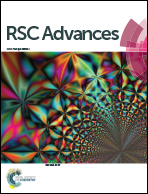Intercalation of the daphnetin–Cu(ii) complex with calf thymus DNA
Abstract
Daphnetin is an important and naturally occurring coumarin compound with potent biological activities. Herein, the coordination between daphnetin and Cu2+ and the in vitro interaction of the daphnetin–Cu(II) complex with calf thymus DNA (ctDNA) were investigated by multivariate curve resolution-alternating least squares chemometrics combined with multiple spectroscopy, ctDNA thermal denaturation and viscosity studies, and visualized by molecular modeling. The results showed that the daphnetin–Cu(II) complex with a stoichiometry of 1 : 1 was formed and its fluorescence was quenched by ctDNA. The intercalation mode of the daphnetin–Cu(II) complex to ctDNA was demonstrated by the increases in DNA viscosity and melting temperature, and competitive binding between the daphnetin–Cu(II) complex and the fluorescence probe ethidium bromide with ctDNA. The analysis of Fourier transformed infrared spectra showed that the A–T bases region of ctDNA was the main binding site for the daphnetin–Cu(II) complex, and the interaction induced the reduction of helicity and base stacking, but the B-form of ctDNA was not changed. Moreover, a DNA cleavage assay suggested that the daphnetin–Cu(II) complex caused cleavage of plasmid DNA due to its strong binding to DNA. This study is expected to offer useful information for understanding the interaction mechanism of the daphnetin–Cu(II) complex with ctDNA, and may provide novel insights into the synergistic effect between daphnetin and Cu2+ in exerting their pharmacological function.


 Please wait while we load your content...
Please wait while we load your content...